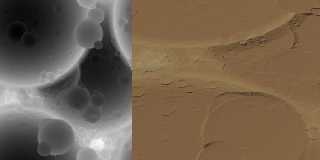|
 |
Ger <No.### [at] Thank You> wrote:
> Mike Sobers wrote:
>
> >>
> > Mike
> >
> > PS - same scene, different lighting
>
> Looks nice but, yes there is one :) , it looks to me that the bottom of some
> craters is actually higher then the surrounding surface. That way it looks
> to me that the crater is added onto the land and not smashed into it.
>
> See attachment
>
>
> --
> Ger
Yes, that can happen. The program takes an average ground level and creates
the crater at that height (the bottom of the crater is always below the
average height). Unfortunately, if there is a slope at that location
(which there always is when a small crater is inside a larger one), the new
crater may have a bottom that is higher than the lowest point on the ground
in that area. The new craters are always parallel to the original ground
plane. To fix this we'd have to calculate a normal to the average slope at
the location of the new crater and then create the crater parallel to the
slope. For now I'm willing to live with it, since tweaking the command
line settings can usually produce a scene that looks realistic enough for a
given situation. You'll find that after a few million craters, areas with
many medium/large craters will evolve upward, while areas with mostly small
craters will evolve downward. The simulation can look very unrealistic for
some seed values if the number of craters exceeds 10 million or so, and if
there are many large craters.
Mike
Image - 800 x 800, max crater size 760 across, 5 million crater impacts. You> wrote:
> Mike Sobers wrote:
>
> >>
> > Mike
> >
> > PS - same scene, different lighting
>
> Looks nice but, yes there is one :) , it looks to me that the bottom of some
> craters is actually higher then the surrounding surface. That way it looks
> to me that the crater is added onto the land and not smashed into it.
>
> See attachment
>
>
> --
> Ger
Yes, that can happen. The program takes an average ground level and creates
the crater at that height (the bottom of the crater is always below the
average height). Unfortunately, if there is a slope at that location
(which there always is when a small crater is inside a larger one), the new
crater may have a bottom that is higher than the lowest point on the ground
in that area. The new craters are always parallel to the original ground
plane. To fix this we'd have to calculate a normal to the average slope at
the location of the new crater and then create the crater parallel to the
slope. For now I'm willing to live with it, since tweaking the command
line settings can usually produce a scene that looks realistic enough for a
given situation. You'll find that after a few million craters, areas with
many medium/large craters will evolve upward, while areas with mostly small
craters will evolve downward. The simulation can look very unrealistic for
some seed values if the number of craters exceeds 10 million or so, and if
there are many large craters.
Mike
Image - 800 x 800, max crater size 760 across, 5 million crater impacts.
Post a reply to this message
Attachments:
Download 'lotsocraters.jpg' (26 KB)
Preview of image 'lotsocraters.jpg'

|
 |




![]()